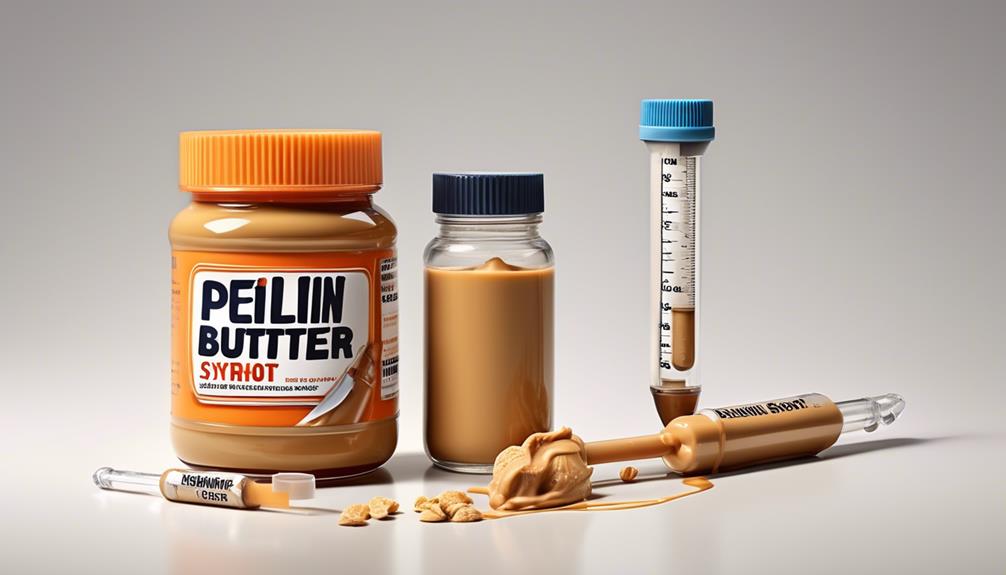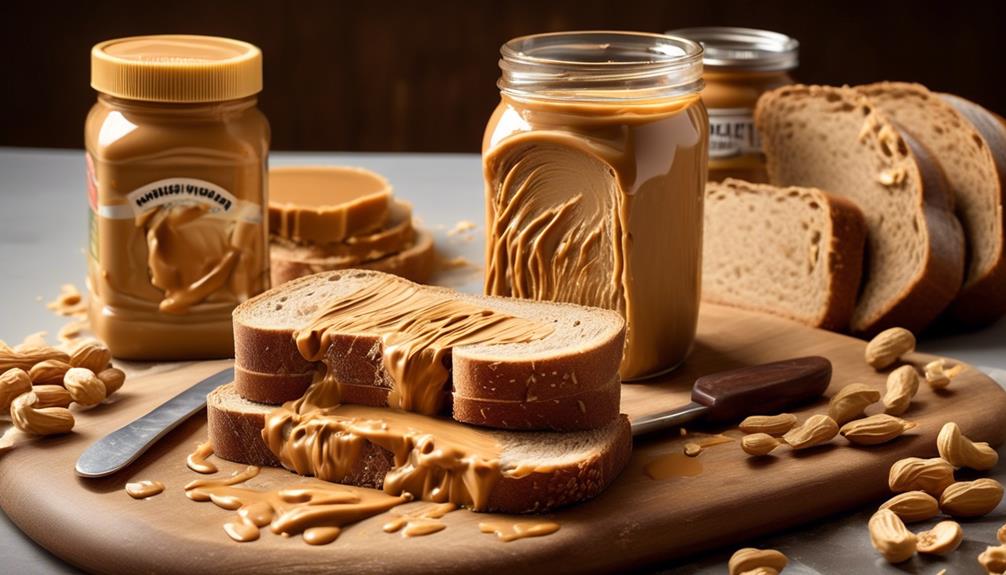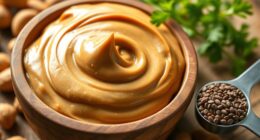To prevent your peanut butter from becoming grainy, it’s important to control temperature and storage conditions. Keep it in a cool, dark place and avoid refrigerating unless specified, as temperature fluctuations cause fat crystals to grow large and grainy. Stir thoroughly before use to distribute fats evenly, and gently warm it if needed to restore smoothness. If you want to learn more about maintaining that perfect creamy texture, keep exploring these helpful tips.
Key Takeaways
- Maintain consistent, moderate temperatures during processing, storage, and reheating to prevent large fat crystal formation.
- Store peanut butter in airtight, cool, dark places to inhibit fat separation and crystal growth.
- Use rapid cooling techniques to promote small crystal formation for a smoother texture.
- Stir thoroughly before use and gently reheat to redistribute fats and break down existing crystals.
- Choose oils with appropriate melting points and avoid refrigeration unless specified to prevent crystallization.
Understanding the Formation of Fat Crystals in Peanut Butter

Understanding how fat crystals form in peanut butter begins with recognizing that the fat content naturally separates during processing. This separation leads to crystal formation, which occurs as the fats undergo fat crystallization. When peanut butter cools or is stored at certain temperatures, the liquid fats begin to solidify into tiny crystals. These crystals develop as molecules arrange themselves into structured patterns, affecting the texture. The rate of fat crystallization depends on factors like temperature fluctuations and fat composition. As crystals grow, they can cause the product to become grainy or crumbly over time. Controlling the temperature during storage and manufacturing helps manage this process, preventing unwanted crystal growth and maintaining a smooth, creamy consistency in your peanut butter. Additionally, understanding hackathons can inspire innovative solutions for food processing and preservation techniques.
Recognizing the Signs of Graininess and Separation
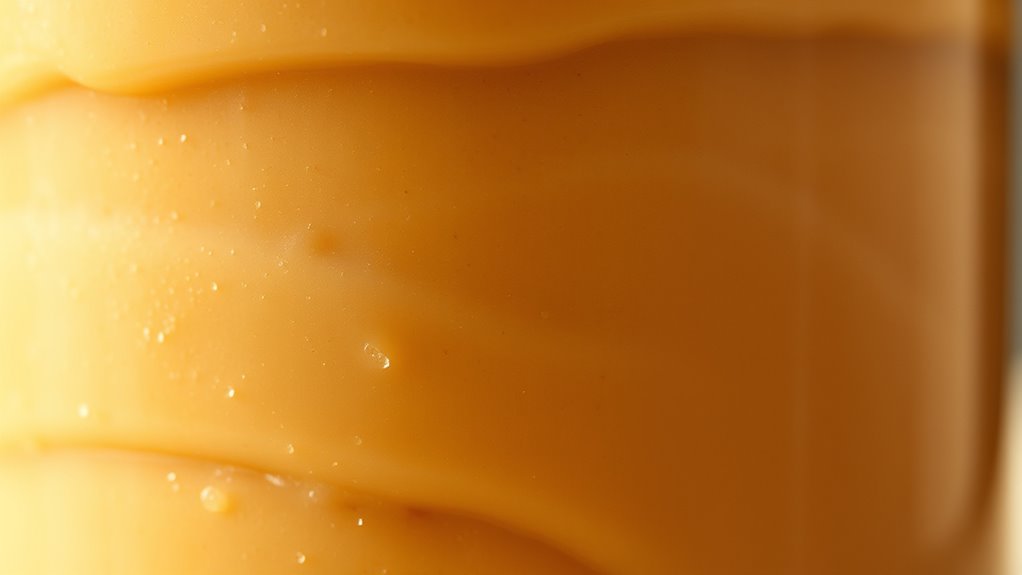
Graininess and separation in peanut butter are clear signs that the product has undergone changes in its internal structure. When you notice a gritty texture or visible oil pooling on the surface, it indicates fat crystals have shifted, affecting the consistency. These signs can hinder your nut butter pairing experience, as the texture may no longer complement the intended flavor profile. Separation often occurs when the oil rises to the top, leaving a thicker layer underneath. Recognizing these signs helps you decide whether to stir, reheat, or replace the product to maintain ideal flavor enhancement. Being attentive to these cues ensures you enjoy smooth, well-textured peanut butter, preserving its taste and ensuring your nut butter pairing remains enjoyable without graininess. Additionally, understanding peanut butter stability can help prevent unwanted separation and maintain a consistent texture over time.
The Role of Temperature in Fat Crystal Development

Temperature control is key to forming the perfect fat crystals in peanut butter. By adjusting the temperature, you can influence how quickly crystals develop and their final texture. Understanding these techniques helps you achieve smooth, consistent results every time. Additionally, maintaining precise temperature settings supports consistent crystal formation, ensuring optimal texture and flavor.
Temperature Control Techniques
Controlling temperature is vital for guiding fat crystal development in peanut butter, as even slight variations can markedly influence texture and stability. To achieve this, you need to monitor nut temperature carefully during processing. Using effective cooling methods helps prevent unwanted graininess by promoting uniform crystal formation. Rapid cooling, such as using chilled surfaces or controlled refrigeration, ensures that fat crystals form consistently, reducing the risk of large, grainy crystals. Maintaining a steady temperature during mixing and storage also plays a indispensable role in preventing temperature fluctuations that could disrupt crystal structure. By precisely managing nut temperature and employing appropriate cooling techniques, you can produce a smooth, stable peanut butter with a desirable texture and minimized graininess. Additionally, implementing automation’s role in temperature control can enhance consistency and precision throughout the process.
Crystallization Rate Effects
The rate at which fat crystals form during peanut butter processing is crucial in determining the final texture, and temperature plays a key role in this process. If you control the cooling rate, you can influence how quickly crystals grow, preventing undesirable fat bloom and graininess. Rapid cooling encourages smaller crystal formation, leading to a smoother texture, while slow cooling allows larger crystals to develop, increasing the risk of graininess. By managing temperature carefully, you regulate crystal growth, ensuring even fat crystal development. Proper temperature control reduces the likelihood of fat bloom, which results from large, unstable crystals. Understanding how temperature affects crystallization rate helps you produce creamy, stable peanut butter with minimal graininess and ideal mouthfeel. Additionally, monitoring crystal size during cooling can help optimize texture and quality.
How Storage Conditions Affect Peanut Butter Texture
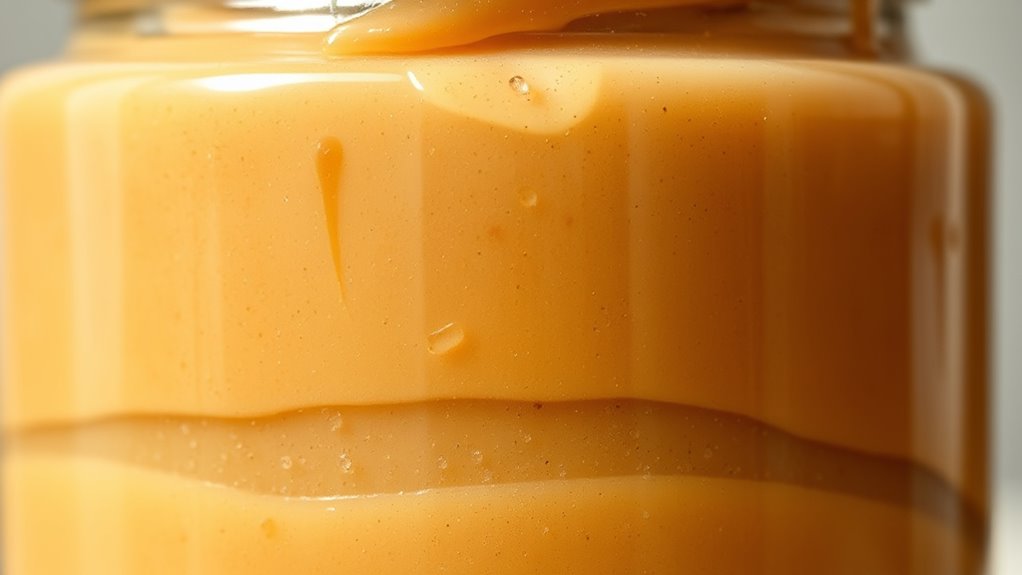
Storing peanut butter improperly can cause its texture to change considerably over time. Exposure to heat or fluctuating temperatures can accelerate fat crystal formation, leading to a grainy, oil-separated consistency that diminishes its nutritional benefits. To maintain a smooth texture, keep your peanut butter in a cool, consistent environment, ideally between 60-70°F. Proper packaging innovations, like airtight containers, help prevent moisture and air from affecting quality. If stored correctly, peanut butter retains its creamy texture and preserves the nutritional benefits, such as healthy fats and protein. Avoid refrigeration unless specified, as cold temperatures can cause fat crystallization and harden the product. Consistent storage conditions are key to preventing graininess and ensuring your peanut butter stays fresh and enjoyable.
Choosing the Right Type of Peanut Butter for Longevity
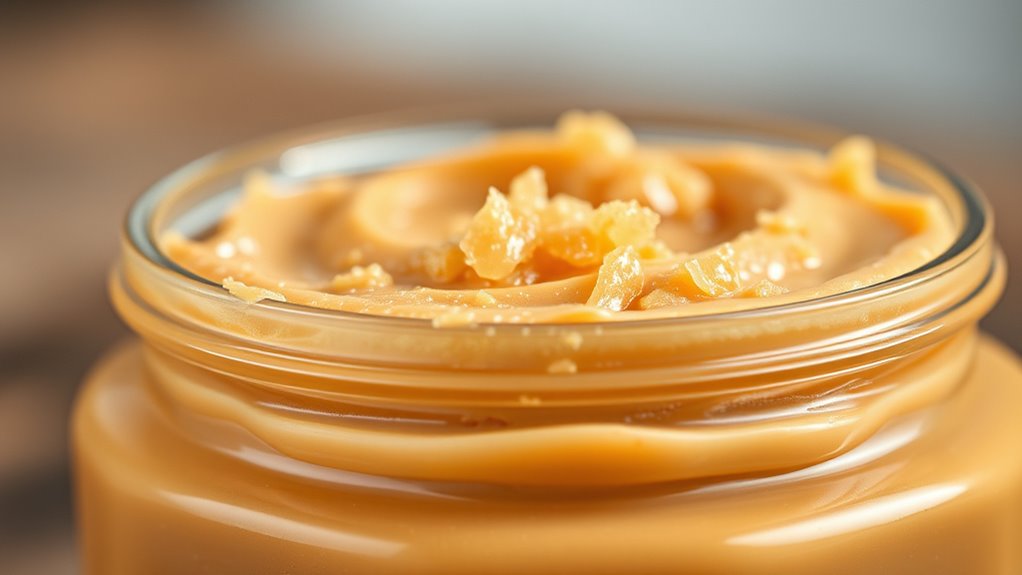
When selecting peanut butter for long-term storage, consider whether natural or processed types suit your needs. Natural peanut butter often has fewer preservatives but may separate more easily, while processed options tend to resist oil separation. Your choice depends on balancing freshness with convenience for lasting quality. Additionally, opting for products with minimal added ingredients can help maintain texture and prevent grainy texture issues over time.
Natural vs. Processed Types
Choosing the right type of peanut butter can considerably impact its shelf life, especially if you want it to last without spoiling. Natural and processed peanut butter varieties differ mainly in ingredient differences, which influence their longevity. Natural peanut butter typically contains just peanuts and salt, with no stabilizers or preservatives, making it more prone to oil separation and spoilage. Processed varieties often include added sugars, emulsifiers, and stabilizers that help prevent oil separation and extend freshness. If you prefer natural peanut butter, you’ll need to store it properly and consume it sooner. Processed types tend to last longer due to their additives, but they may contain ingredients that affect the texture and crystallization. Choosing the right type depends on your storage preferences and how long you want it to stay fresh.
Oil Separation Resistance
If you want your peanut butter to stay smooth and prevent oil separation, selecting the right type is essential. Look for options labeled as “stabilized” or “oil-separated resistant,” as they’re formulated to maintain consistency over time. These types often contain added emulsifiers or processing methods that improve oil retention, enhancing shelf life. Choosing the right peanut butter not only preserves its texture but also retains its nutritional benefits, ensuring you get healthy fats and protein without the mess. Additionally, stabilized varieties can boost flavor enhancement by maintaining a uniform taste profile, even after extended storage. By selecting a peanut butter designed for oil separation resistance, you enjoy a smooth, flavorful spread that lasts longer without sacrificing nutritional value. Regularly maintaining your mailing list helps ensure your product stays fresh and appealing to consumers over time.
Proper Techniques for Storing Peanut Butter
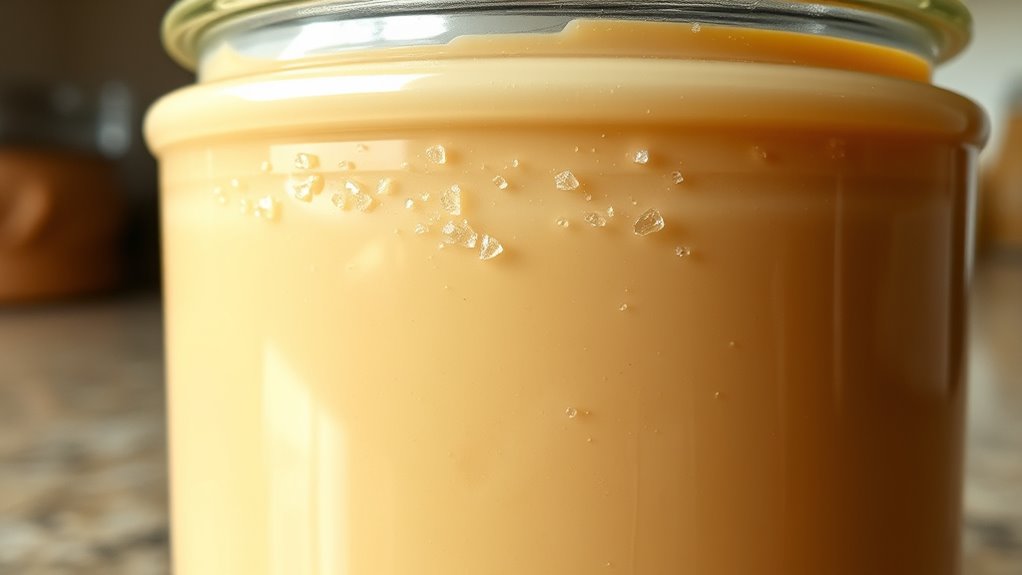
Proper storage is essential to maintain the quality and texture of your peanut butter. To prevent issues like peanut butter molds and flavor loss, keep it stored correctly. Always use an airtight container to block moisture and air exposure, which can cause spoilage and graininess. Store your peanut butter in a cool, dark place away from direct sunlight to preserve flavor and prevent fat separation. Avoid refrigerating it unless specified, as cold temperatures can cause crystallization. Additionally, stirring your peanut butter before sealing helps distribute fats evenly, reducing the chance of graininess. Proper storage techniques are also important for preventing fat separation and maintaining consistency over time.
Tips for Restoring Grainy Peanut Butter to Creaminess

When your peanut butter becomes grainy, you can often restore its smoothness with a few simple techniques. First, stir the peanut butter thoroughly to break up fat crystals. If it’s still grainy, try gently warming it—avoid overheating to prevent nut allergy reactions or packaging damage. Place the jar in warm water or microwave in short bursts, stirring in between. Consider the packaging; some containers don’t handle heat well. To prevent future graininess, store peanut butter in a cool, consistent environment. Using proper storage methods can help maintain texture integrity and prevent separation. Use the following table for quick tips:
| Technique | Precaution | Outcome |
|---|---|---|
| Gentle warming | Avoid overheating | Restores creaminess |
| Stirring thoroughly | Be gentle to avoid breakage | Distributes oils |
| Proper storage | Keep in cool, consistent temps | Maintains smoothness |
The Impact of Heating and Cooling on Fat Crystals
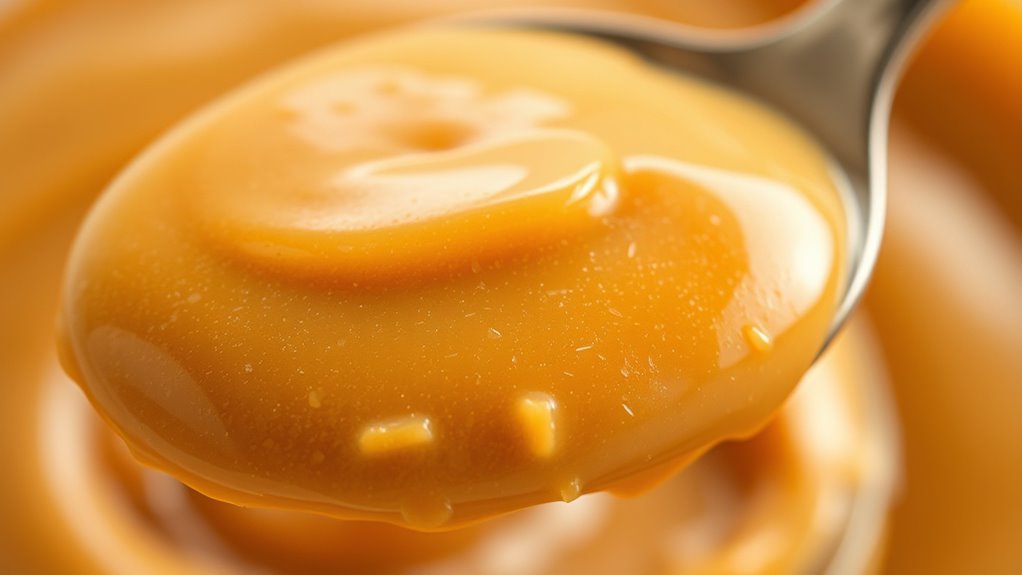
Heating and cooling considerably influence the formation and resolution of fat crystals in peanut butter. When you heat it, the fat melts, breaking down existing crystals. Proper cooling then allows new crystals to form, affecting texture. Controlling nut temperature during heating guarantees even melting without overheating. Using effective cooling techniques, like rapid chilling, helps prevent large, grainy crystals from forming. Additionally, understanding the role of temperature control is crucial in managing fat crystal size and distribution.
Best Practices to Maintain a Smooth and Creamy Consistency
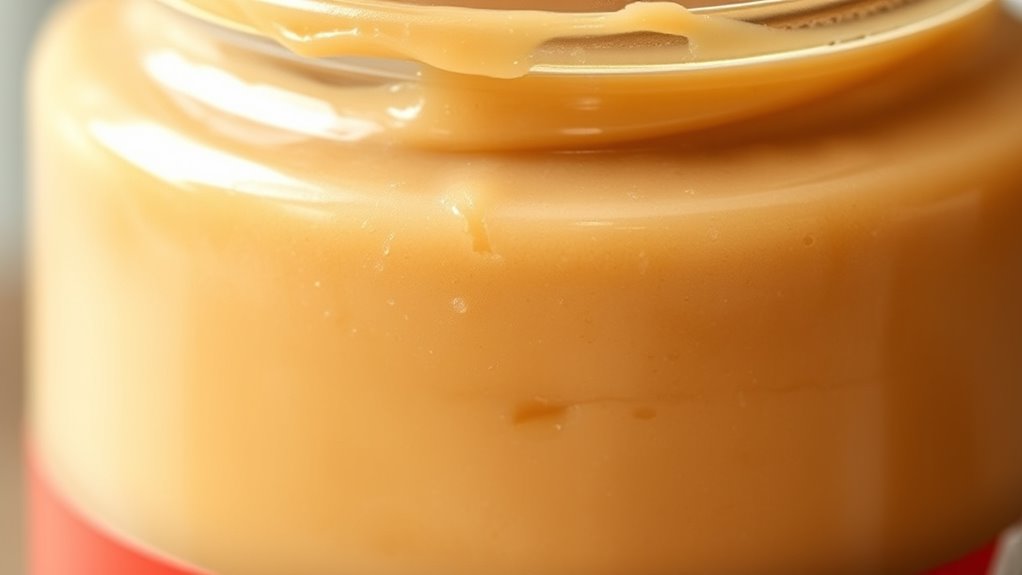
Controlling the temperature during both heating and cooling stages is key to maintaining a smooth and creamy peanut butter. Keep the temperature steady to prevent fat crystals from forming grainy textures. If you want flavor variations, choose ingredients like honey or cocoa powder carefully, guaranteeing they don’t disrupt the smooth consistency. Ingredient substitutions, such as using different oils, can also influence texture—opt for oils with stable melting points to avoid separation or grittiness. Stir thoroughly during blending, especially after heating, to evenly distribute fats and prevent crystallization. When cooling, do so gradually to allow fats to set smoothly. Following these best practices ensures your peanut butter stays creamy, regardless of flavor variations or ingredient swaps.
Frequently Asked Questions
Can Natural Peanut Butter Develop Fat Crystals Faster Than Processed Varieties?
You might wonder if natural peanut butter develops fat crystals faster than processed types. Since natural fats have a crystalline structure, they tend to crystallize more readily, especially if stored at cool temperatures. Without added stabilizers, natural peanut butter is more prone to forming fat crystals quickly, which can lead to a grainy texture. To prevent this, keep your natural peanut butter at consistent, moderate temperatures and stir it regularly.
Does Adding Oil Help Prevent Graininess in Homemade Peanut Butter?
Adding oil is like giving your homemade peanut butter a spa day—smoothing out its texture and preventing graininess. When you include oil, it helps distribute the fat crystals evenly, making your peanut butter creamier and silkier. This oil addition acts as a buffer, reducing the chance of fat crystallization that leads to a grainy feel. So, yes, adding oil can effectively help you achieve a smoother, more enjoyable spread.
Are There Specific Brands Less Prone to Fat Crystal Formation?
When choosing a peanut butter, you might wonder if some brands are less prone to fat crystal formation. Focus on brand reputation and ingredient transparency—brands known for high-quality ingredients and minimal additives often produce smoother results. These brands tend to use stable oils and proper processing, reducing graininess. By selecting trusted, transparent brands, you increase your chances of enjoying a creamy, crystal-free peanut butter every time.
How Does Humidity Influence Peanut Butter Texture Over Time?
Humidity plays a key role in peanut butter texture over time. When storage humidity is high, moisture absorption can cause the oil to separate or make the peanut butter feel sticky. On the other hand, low humidity helps maintain a smooth, consistent texture by preventing moisture transfer. To keep your peanut butter fresh and prevent changes, store it in a cool, dry place and avoid exposure to fluctuating humidity levels.
Can Freezing Peanut Butter Impact Its Fat Crystal Development?
Think of freezing peanut butter as locking a moment in time, like capturing a delicate snowflake. Freezing effects can slow down or halt crystal formation, preventing the fat crystals from growing into a grainy texture. However, if not sealed properly, moisture and temperature fluctuations might cause unwanted changes. So, while freezing can preserve smoothness by inhibiting crystal development, careful storage is key to maintaining that creamy consistency.
Conclusion
By understanding how fat crystals form and mastering proper storage techniques, you can keep your peanut butter smooth and enjoyable. For example, imagine buying a jar that stays creamy despite months on the shelf—it’s all about controlling temperature and choosing quality. With these tips, you’ll prevent graininess and guarantee every spread remains fresh and velvety. Taking these simple steps means you’ll always enjoy perfect peanut butter, no matter how long it’s been stored.



